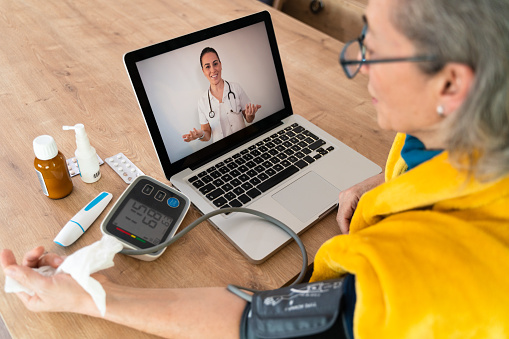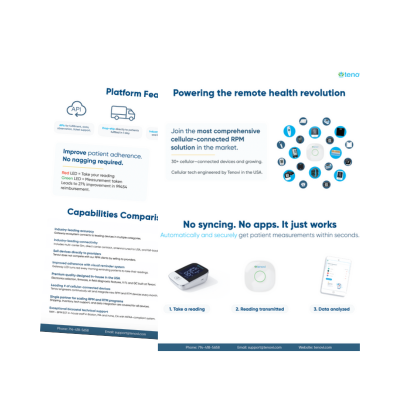Most teams comparing cellular bluetooth medical monitoring devices start with the basics of bluetooth vs. cellular, but there’s a piece missing from that conversation. Bluetooth devices, cellular-enabled devices, and cellular-connected gateway devices each solve different problems in remote patient monitoring. Understanding how all three work helps you pick the model that fits your patient population, your staffing bandwidth, and the outcomes you’re trying to drive.
Understanding the differences across cellular Bluetooth medical monitoring devices, cellular-enabled devices, and gateway-connected Bluetooth devices helps health organizations choose the model that aligns with patient needs mix, staffing capacity, and the long-term goals of an RPM program. This guide breaks down the differences, how devices connect and transmit data, setup, maintenance, and patient use. We explore speed, reliability, cost, and integration options, including when a cellular Gateway makes sense and how device type can impact patient adherence to measurements.
Cellular and Bluetooth Medical Monitoring Devices
Bluetooth and cellular medical monitoring devices both send biometric data to clinicians in real time. Blood pressure, weight, blood glucose, oxygen saturation, pulse rate, and other vitals flow into your RPM platform and create a day-to-day clinical picture.
The experience behind the scenes is where these technologies differ. Bluetooth RPM devices are familiar and often cost-effective. Some Bluetooth devices rely on a smartphone to collect and transmit data. For tech-savvy users, this may work fine.
For senior patients, this can become a barrier to adherence. Cellular devices send data directly over cellular networks. Some companies offer proprietary “cellular-connected” Bluetooth devices that send data through a cellular hub instead of a phone. In this setup, the device itself remains Bluetooth, but the connectivity burden shifts to the gateway. That distinction becomes important when evaluating patient experience and long-term adherence. The best choice depends on workflow, patient demographics, and how much support staff time you want tied up in troubleshooting.
Gateway Technology & How it Connects Multiple Bluetooth Devices
Gateway technology allows multiple Bluetooth devices to connect to one cellular gateway. The gateway then sends the health data to a cloud and then pushes the data to an RPM dashboard. For example, the Tenovi Gateway allows multiple RPM and RTM wireless devices like blood pressure monitors, pillboxes, scales, blood glucose meters, and pulse oximeters to connect and transmit data to be stored in the Tenovi cloud. The data can then be sent to any RPM platform for review.
The Tenovi Gateway offers the following features.
- Seamlessly connects to over 40 RPM and RTM devices.
- Connects to cellular carriers in the U.S.
- Removes the high cost of cellular connection for each cellular-enabled device
- Automatically transmits patient data to HIPAA-compliant Tenovi Cloud.
- Non-obtrusive visual reminders to improve patient adherence.
- Ready for use right out of the box – no syncing or apps are required
- One central device to manage instead of multiple Bluetooth monitoring devices.
- It is more customizable by integrating multiple monitoring devices tailored to the patient’s needs.
- The Gateway integrates, stores, and aggregates data from multiple monitoring devices.
RPM Bluetooth Medical Devices
Some Bluetooth devices require a complex pairing process on a smartphone. Patients may encounter further difficulty if the device does not remain connected. When this happens, the patient often must establish connectivity multiple times. Devices may also require updating or reformatting from time to time.
Tenovi’s Blood Glucose Meter is a top-line FDA-cleared class 1 RPM device that does not require syncing or apps. It includes a cellular-connected meter, lancets, and test strips. Tenovi offers a replenishment supply program for lancets and test strips for added convenience.
Cellular RPM Medical Devices
Cellular RPM devices transmit patient vital sign monitoring data via the same cellular network as mobile phones. The best RPM devices use widespread cellular providers to transmit data. To make that possible, the cellular remote monitoring device company works with area cell phone service providers to utilize their coverage networks.
One advantage of cellular RPM equipment is that data is transmitted via a cellular connection, which works anywhere within the cellular range. Cellular telehealth RPM medical devices provide more accessibility, making them a good choice for specific patient populations.
Tenovi’s cellular-enabled blood glucose meter is one example of a cellular remote patient monitoring device.
Device Set up
When it comes to RPM patient device setup and Bluetooth vs. cellular, patients with a quick and easy setup experience will likely continue using RPM devices. This means that adherence to taking daily measurements may be more likely. Regular readings give physicians the data they need to adjust a patient’s treatment plan and avoid hospitalization. It can also make a big difference to patients and caregivers managing a chronic condition such as heart failure, kidney disease, Alzheimer’s, or diabetes.
Bluetooth Medical Device Setup
Geriatric patients and those who are not tech-savvy may need help with setting up a Bluetooth RPM device. Patient satisfaction and ease of use are crucial to keeping patients engaged and excited about regular health monitoring. Because of pairing issues, patients may require technical support.
All the patient has to do is plug in the Gateway and then perform the following steps with clean hands:
- Insert the test strip into the meter
- Wipe your finger with an alcohol pad and let it dry
- Gently prick the side of the finger with the lancet
- Place a drop of blood onto the test strip and wait for the reading
- The Data is automatically sent to your healthcare team
Cellular Medical Device Setup
Cellular remote patient monitoring hardware devices require no connection setup and work anywhere outside of the home with cellular coverage. This makes using RPM technology easy for all patients, especially those struggling with technology. The device works out of the box, and an internet connection is unnecessary. For example, you can watch this short video to see how simple setting up an rpm scale can be.
However, the use of cellular technology-based remote patient monitoring devices is limited by the geographical coverage of the cellular network provider, which can pose connectivity challenges in remote or ultra-rural areas. Furthermore, if the RPM device company does not use multi-carrier providers, data transmission may be compromised in the event of a cellular network outage.
- Unscrew the lancing device cover from the body of the lancing device.
- Insert a lancet into the lancing device and push it until it stops completely.
- Twist and remove the safety tab and screw the cover back onto the lancing device.
- Adjust the puncture depth by rotating the cover.
- Pull the cocking barrel back to set the lancing device.
- Take a blood sample with the lancing device.
- Insert a test strip into the meter in the direction of the arrows.
- Apply the blood sample to the end of the test strip.
- The Data is automatically sent to your healthcare team
Cellular or Bluetooth RPM Devices and Speed
Cellular remote patient monitoring devices are rapidly advancing, leveraging the increased speed and reliability of 5G networks. This enables the immediate transmission and real-time recording of data, which healthcare providers can access almost instantaneously, facilitating prompt intervention when necessary.
Some Bluetooth devices often require users to log into an app before submitting their data to their provider. Providers may not get those immediate updates, and the process adds an extra step for patients to remember, which could significantly affect compliance. When using gateway technology, speed is not a concern for Bluetooth devices.
Bluetooth and Cellular Monitoring Devices and Price
Bluetooth devices generally cost less than cellular devices. The higher cost for cellular-connected and cellular RPM devices may be worth the investment, as they are supported by a broader network, promoting simplicity and ease of patient use.
Remember, regular, quality data is always helpful when it comes to understanding a patient’s condition. Remote patient monitoring requires patients to use their devices at least 16 days a month. Frequent measurements accumulate fast and provide clinicians with valuable insights for optimizing treatment plans. Cellular or Bluetooth RPM devices may be well worth the cost when it comes to patient satisfaction and patient adherence.
Bluetooth vs. Cellular: Which Choice is Better for Your Strategy?
Cellular or Bluetooth medical monitoring devices are available for several uses: wireless blood pressure monitors, wireless weight tracking scales, wireless blood glucose monitors, wireless pulse oximeters, and more. RPM companies offer various cellular and Bluetooth device types to choose from. Here is a quick summary of the benefits of cellular vs. Bluetooth.
Bluetooth device benefits:
- Bluetooth is the more cost-effective option.
- Multiple Bluetooth devices can connect to a cellular gateway for fast health data transmission.
- A more comprehensive array of Bluetooth devices is available for healthcare providers and patients.
Cellular device benefits:
- With a multi-carrier contract, it quickly transmits patient health data to remote patient monitoring software platforms.
- Easy for the patient
- More likely to remove frustration with no downloading apps or syncing needed.
- Patients can use devices right out of the box for a seamless experience.
Meet a Better RPM Experience
High patient adherence rates are critical to a successful patient monitoring program. Are you looking for a better experience that offers cellular and Bluetooth device options for managing heart health, COPD, or other chronic conditions in patient care? Schedule your free demo with Tenovi, and get ready to meet a better RPM experience.


